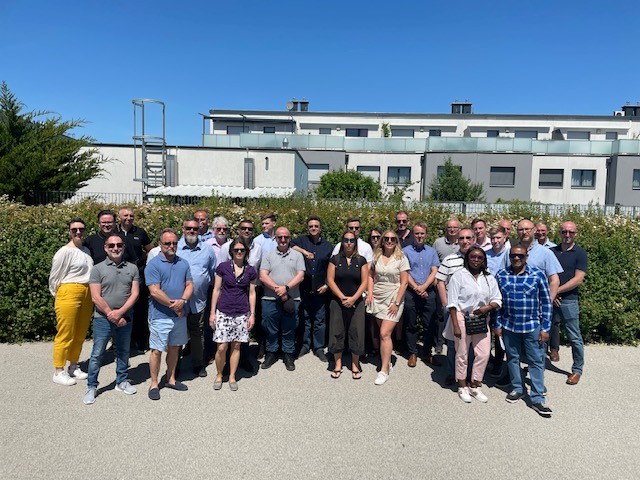A Whirl Around Viennese Social Housing
Amy Jansen, Creative Director at Brouha Marketing joined the National Housing Maintenance Forum’s Study Tour Vienna 2022 earlier this year for an eye-opening exploration of how a country’s 100-year history of social housing has evolved into an inclusive, modern, and socially and environmentally aware system.

Until I started writing the Social Housing series 2 years ago, for the BrouHappy podcast, Social Housing wasn’t something I knew very much about. I was aware of it as an essential part of our society, I understood in an academic way the significance it played in the lives of those living within the system, and I was conscious of the contentious place it held within the historical and social fabric of England … but these were superficial understandings. I was ignorant of the deeper issues and nuances that shaped this topic far more than I could ever imagine. My dive into the history of social housing in this country was fascinating, heart-warming, deeply saddening… as is with anything that holds and effects the lives, legacies and futures of human beings.When the chance to join the National Housing Maintenance Forum (NHMF) Study tour to Vienna, I jumped at it. The NHMF’s sole purpose is to support and promote best practice in social housing maintenance, and as my only real point of reference had been the UK system – and yes, I understand that can, at the most generous, be described as academic – here was the opportunity to see how another country went about it in the company of industry experts, and as well as expand my understanding of the system as a whole.
Next stop, Vienna
The NHMF study tours began with the aim to explore how other European countries approached their social housing so that those in the industry could learn from other models, and potentially bring lessons back that could benefit England. This year’s tour was to Vienna, and the two days planned by the committee were full of visits to social housing programmes and talks from expert representatives from Austria’s Housing Authorities.
Vienna’s history of social housing starts well before any buildings were built or residents housed. As with anything, the historical context is intimately entwined in the place that Vienna finds itself today so, before I get into the tour itself, I think it’s important to take a look back.
100 years in the making
World War One may not have had an immediate impact on the city, but the economic embargo imposed by the victorious Entente powers – France, the UK and Russia – meant that food and clothing became scarce. Housing also became increasingly hard to find. Refugees from across the Austrian Galicia filled Vienna’s streets, and once fighting had ceased, the former soldiers of the Imperial and Royal Army joined them, too. By 1918, the population of Vienna was nearly 2 million, higher than it is today.
Rather than subletting rooms, people were renting out beds, and those on night shifts would switch with those on the day shifts. Our tour guide on the first day of the tour joked that there wasn’t a cool bed left in Vienna at the worst of it, and I can see what he means. There was so little time between occupants, that beds were constantly warm. As a result, the sanitation of these houses and beds was, as you could imagine, devastatingly poor, and illnesses such as tuberculosis and the Spanish flu were rife.
SDAP paints social housing red
In 1918, the Social Democratic Workers’ Party of Austria, the SDAP took power of Vienna, and even for a short time, the whole of Austria. It was under the SDAP that Vienna saw the beginning of social housing traditions it recognises today. They put in place a rigorous programme of construction projects across the city in response to the housing shortages, and implemented policies to improve standards of public education, healthcare and sanitation. Many of the Gemeindebauten – or what we would call municipal housing complexes – built at the time survive through to today.
The aim of many of the initiatives was to create community rather being exclusory. By integrating social classes, it meant that social housing became more than simply building a place to live, but instead to create liveable, integrated social communities that offered high standards of living at an affordable price.
A social responsibility
Vienna is one of the fastest growing cities in Europe, and because they deem housing a service for the people, along with transport, water supply and waste management, it’s not something they feel can be privatised. As such, the city invests over 350 million Euros each year on housing construction and refurbishment, with a further 85 million euros as contribution towards those who aren’t able to meet their already subsidised rents. This socially aware approach to social housing has meant that Vienna has seen a drop in evictions due to missed rent by two-thirds.
Our first official stop was to a talk by Gerald Kossl, head of Housing Research & Policy at the Austrian Federation of Limited-Profit Housing Associations, GBV. GBV is a membership organisation made up of private companies, either not profit-driven or state dependent, and housing cooperatives. Together, these companies cater for just over 2 million people, roughly 24% of the Austrian population. Nearly all of that housing is mixed tenure multi-storey blocks, which as I mentioned a moment ago, is a tenet that has remained from the SDAP days. The developments, the tenure of choice for low and middle-income households, provide that integrated social mix, and removes the stigma of living within the social housing system.
Gerald took us through the finer points of the financing of these schemes – mostly bank and public loans with the remaining funding coming from tenants’ contributions and HA equity, the sustainability strategies, and how local management and tenant representation is put in place to maintain the sense of community within the complexes. In terms of the sustainability efforts of these schemes, Gerald explained that most of the housing is on district heating, and green landscaping is used to combat heat island effects, and their commitment to a circular economy for building materials.
The reality of Viennese social housing
The rest of the first day was spent touring a number of social housing developments which was absolutely eye opening. I don’t feel that I’m exaggerating when I say that I was blown away by the facilities. Each project included kindergartens, schools, pharmacies, doctors … everything that the residents could need. One complex had swimming pools on the roof, a gym, sauna, physio and physical therapy studios, an acoustically soundproofed music room, as well as allotments available to residents on 12-month leases.
Each project was clean, tidy, shoes racks were left outside front doors, bikes and children’s buggies were left undisturbed in the spaces under stairs, and one of my tour fellows discovered, having summoned the elevator, that the mirror on the rear wall was entirely intact and unmolested. I know that may sound like I’m being flippant, but really, I’m not. The experience of so many on the tour was that of shock. Based on their first-hand experiences with social housing in the UK, this was almost unrecognisable as social housing. Much of the conversation that came from these visits bordered on incredulous … there was no question about this being a place they would like to see UK social housing end up, but the question was, how? What changes would be needed within the system we have in place to see these kinds of scenes in the English multi-storey social housing complexes? As you would imagine, there wasn’t a consensus reached, but there was an enormous amount of inspiration found within those hallways and green spaces.
The system can work
I think what I have come away with from this tour is a profound realisation of the good that social housing can do for the society in which it functions. It can provide dignity and security to those who need it most, as well as maintaining a connection between all those that live in it. I am well aware that any change to an already established system like ours in the UK will be slow, as it’s not just the housing associations that have stakes in it, but that the socially integrated and pleasant spaces seen around Vienna are achievable with the right investment of time and finances.
I have also left knowing full well that I will need to go back and explore the city and its history further.
***
Brouha Marketing is a boutique PR and Marketing firm based in Wiltshire. Brouha Marketing sits within the built environment sector, with a special focus on social housing and the environmental issues. For more information visit brouhamarketing.com, or email, hello@brouhamarketing.com
For those of you reading the official NHMF report, written by Andrew Burke, you will find it here, and if you would like to register your interest for the next tour, you can contact Joanna Gawlinska at joanna@m3h.co.uk.


